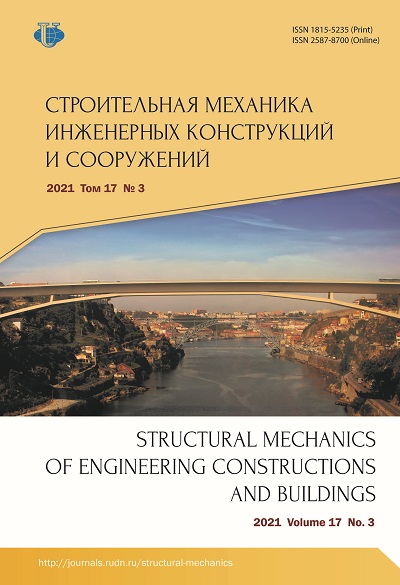Roll-over stability as a problem of high-rise buildings’ designing
- Authors: Inozemtseva O.V.1, Inozemtsev V.K.2, Murtazina G.R.2
-
Affiliations:
- Construction Bureau “SmartProekt”
- Saratov State Technical University named after Yu.A. Gagarin
- Issue: Vol 17, No 3 (2021)
- Pages: 228-247
- Section: Analysis and design of building structures
- URL: https://journals.rudn.ru/structural-mechanics/article/view/29289
- DOI: https://doi.org/10.22363/1815-5235-2021-17-3-228-247
Cite item
Full Text
Abstract
Roll-over stability of tall buildings under wind loads is considered. The nonlinear nature of the problem is taken into account, including geometric, physical, and structural non-linearity. The problem is solved on the base of a system of linearized incremental equations of structural mechanics that describes the behavior of a system “tall building - foundation soil”. Several methods are examined for solving nonlinear problems of roll-over stability, specifically: 1) deformation method of systems’ equilibrium states’ tracing; 2) method of linearization of nonlinear equations and systems’ equilibrium states’ tracing; 3) method of linearization of nonlinear physical relations of a systems with constructive, static, geometric nonlinearity; 4) method of linearization of nonlinear physical relations of a system with constructive nonlinearity based on nonlinear incremental structural mechanics; 5) method of the deformation process tracing for a physically nonlinear soil base, given the increase of discharge zones and constructive nonlinearity. Each of these methods is used to solve a model task. These tasks take into account roll-over stability of high structures under action of wind loads. In general, the problem of roll-over stability of a high object can be represented as repeatedly nonlinear one with various types of non-linearity. In this regard, in the practice of high-rise buildings’ designing, it is necessary to develop scientifically and methodically substantiated methods of assessing roll-over stability, considering non-linear factors. Taking these factors into account will make it possible to assess the roll-over stability of a high-rise object more accurate.
About the authors
Olga V. Inozemtseva
Construction Bureau “SmartProekt”
Author for correspondence.
Email: olga.inozemtseva@yandex.ru
leading designer, Candidate of Technical Sciences
26B Bolshaya Pochtovaya St, bldg. 2, Moscow, 105082, Russian FederationVyacheslav K. Inozemtsev
Saratov State Technical University named after Yu.A. Gagarin
Email: olga.inozemtseva@yandex.ru
SPIN-code: 8384-7039
Professor, Department of Building Materials, Structures and Technologies, Doctor of Technical Sciences
77 Politekhnicheskaya St, Saratov, 410054, Russian FederationGulsem R. Murtazina
Saratov State Technical University named after Yu.A. Gagarin
Email: olga.inozemtseva@yandex.ru
SPIN-code: 2225-0830
postgraduate student, Department of Building Materials, Structures and Technologies
77 Politekhnicheskaya St, Saratov, 410054, Russian FederationReferences
- Pavlyuk N.P. On the question of checking the stability of the wall to overturning. Proekt i Standart. 1934;(8):21–26. (In Russ.)
- Pavlyuk N.P. Stability of rigid walls and columns. Trudy Leningradskogo Instituta Inzhenerov Kommunal'nogo Stroitel'stva. 1935;(II):7–26. (In Russ.)
- Levin Ya.B. Stability of rigid walls and columns on an elastic and elastoplastic foundation. Inzhenernyj Sbornik. 1950;VII. (In Russ.)
- Levin Ya.B. On the stability of rigid walls and arrays on an elastic foundation under the action of arbitrarily directed, including rotating forces. Trudy Voronezhskogo Inzhenerno-Stroitel'nogo Instituta. 1950;(2). (In Russ.)
- Panovko Ya.G., Gubanova I.I. Stability and vibrations of elastic systems: modern concepts, errors and paradoxes. 3rd ed. Moscow: Nauka Publ.; 1979. (In Russ.)
- Levi-Civita T., Amaldi U. Lezioni di meccanica razionale (vol. 1, part 2). Bologna: Zanichelli; 1923.
- Rabinovich I.M. Questions of the theory of static analysis from structures with one-way connections. Moscow: Stroiizdat Publ.; 1975. (In Russ.)
- Schulz M., Pellegrino S. Equilibrium paths of mechanical systems with unilateral constraints. Part I. Theory. Proceeding of the Royal Society. Ser. A. 2000;456(8):2223–2242.
- Perelmuter A.V., Slivker V.I. Equilibrium stability of structures and related problems. Moscow: SKAD SOFT Publ.; 2011. vol. II. (In Russ.)
- Lago A., Trabucco D., Wood A. Damping technologies for tall buildings. Butterworth-Heinemann; 2018.
- Fu F. Design and analysis of tall and complex structures. 1st ed. Butterworth-Heinemann; 2018.
- Rajapakse R. Construction engineering design calculations and rules of thumb. 1st ed. Butterworth-Heinemann; 2016.
- Yoo C., Lee S. Stability of structures. 1st ed. Butterworth-Heinemann; 2011.
- Kollar L., Tarjan G. Mechanics of civil engineering structures. 1st ed. Woodhead Publishing; 2020.
- El-Reedy M. Onshore structural design calculations. 1st ed. Butterworth-Heinemann; 2016.
- Sadd M.H. Elasticity: theory, application and numerics. 4th ed. Academic Press; 2020.
- Patel A. Geotechnical investigations and improvement of ground conditions. 1st ed. Woodhead Publishing; 2019.
- Ratner L.W. Non-linear theory of elasticity and optimal design. 1st ed. Elsevier Science; 2003.
- Collatz L. Eigenvalue problems. Moscow: Nauka Publ., Gl. red. fiz.-mat. lit.; 1978. (In Russ.)
- Petrov V.V. Non-linear incremental building mechanics. Moscow: Infra-Inzheneriya Publ.; 2014. (In Russ.)
- Vlasov V.Z. Selected works. Moscow: Nauka Publ.; 1964. vol. 3. (In Russ.)
- Ter-Martirosyan Z.G. Soil mechanics. Moscow: Izd-vo Assotsiatsii stroitel'nykh vuzov Publ.; 2009. (In Russ.)
- Zolotareva L.A. Structural design. Taganrog: Publishing House of the Southern Federal University; 2018. (In Russ.)
- Poston T., Stewart I. Catastrophe theory and its applications. London: Pitma; 1978.
















